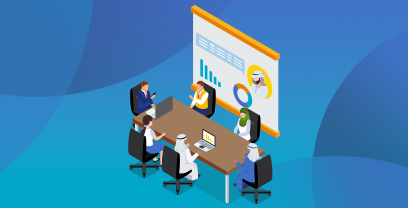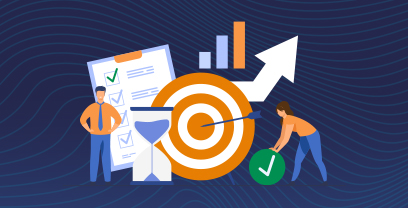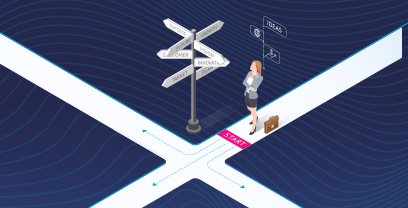At IvaluaNOW, an inspirational panel discussion brought together procurement leaders from across industries to discuss the transformational impact of procurement technology.
Key Takeaways:
- Adopting procurement technology is a significant undertaking, requiring careful planning, stakeholder alignment, and effective change management.
- Leading companies have exceeded their goals and expectations through successful procurement technology adoption.
- As procurement undergoes a major transformation, AI-powered technology will play a pivotal role in future-proofing operations.
Led by our very own Global SVP – Value Engineering, Solution Consulting & Services, Ari Stone, Thierry Blomet, Senior Vice President, Global Sourcing at Kemira, Matteo Perondi, Chief Procurement Officer at Bulgari (LVMH Group), Reto Rietmann, Co-Leiter Indirekte Beschaffung, Migros, and Jos Joos, Head of Procurement & Supply Chain at KPMG Advisory Belgium, revealed how investing in procurement technology can be a game-changer for organizations, transforming processes along the Source-to-Pay (S2P) spectrum.
Read on to discover key insights into setting procurement technology goals, overcoming adoption challenges, driving success, and predictions for the future.
Key Benefits of Procurement Technology
“Implementing an S2P platform is a huge opportunity to reach the next level of material maturity in the procurement organization.” confirmed KPMG’s Jos Joos.
Digitizing and automating tasks across the entire Source-to-Pay (S2P) process unlocks savings opportunities, increases spend visibility to reduce maverick spending, and strengthens supplier relationships. These are just a few of the significant benefits that procurement technology provides, enabling organizations to optimize efficiency, enhance compliance, and drive strategic value. The rise of advanced AI capabilities and autonomous agents can take procurement’s strategic impact to yet another level.
Taking Procurement to the Next Level with Ivalua
The panelists adopted Ivalua’s procurement technology for its adaptability and comprehensive features. Matteo Perondi, from luxury brand Bulgari, emphasized that Ivalua’s ecosystem allowed the flexibility to integrate modularly without compromising an organization’s agility. He outlined a clear investment in people and technology to support business agility and resilience. Bulgari envisioned a modular platform that could function like a plug-and-play ecosystem, with user-friendly interfaces enabling swift decision-making. “We wanted a tool that is as easy as installing a mobile app,” he said, reinforcing the importance of accessibility.
Thierry Blomet of Kemira, a global leader in sustainable chemical solutions for water-intensive industries, was looking for a digital solution that could automate non-value-adding tasks and integrate seamlessly, internally across systems, and externally with their partners. He also highlighted Ivalua’s capabilities in strategic sourcing.
Jos Joos, KPMG, who has worked on numerous procurement technology implementation projects throughout his career, emphasized Ivalua’s strong integration with external data providers.
For Migros, Switzerland’s largest retail group, finding an end-to-end S2P platform tailored to its unique requirements was essential. With over 25,000 users, prioritizing user-friendliness wasn’t just an option—it was a necessity. According to Reto Rietmann, the initiative aimed for “seamless integration without major disruptions,” ensuring that employees across their 40 subsidiaries could adopt the platform effortlessly and maintain productivity without interruption.
Driving Adoption: Overcoming Challenges and Changing Mindsets
Resistance to change remains one of procurement’s biggest hurdles when implementing new technology. Organizations must address barriers–including cultural resistance, unclear processes, and stakeholder alignment.
Communication & Change Management are Crucial
During the panel, both Blomet and Rietmann highlighted the importance of change management and strong communication. Change management played a pivotal role in Migros’ success. Rietmann highlighted how his team strategically engaged C-level executives, procurement professionals, and IT departments to gain their support and alignment early in the process, ensuring a smooth and cohesive implementation. Successfully onboarding key users and illustrating how the solution could significantly improve their daily business operations were both critical steps. Communicating this vision effectively across all relevant departments ensured alignment and understanding of its value, he explained.
From Bulgari’s perspective, Matteo Perondi stressed his business-first mindset. According to Perondi, procurement should not just be seen as a tool to enable compliance or cost control. He wanted to bring tangible value to the business by improving agility and decision-making through technology. This approach helped position procurement technology as a strategic advantage rather than just another operational platform.
Ensure C-level Buy-in and Stakeholder Engagement
Jos Joos emphasized early involvement of stakeholders, especially at the executive level. He highlighted that success stems from clearly demonstrating how technology offers targeted solutions to specific pain points while delivering measurable and impactful results. He also emphasized the importance of involving external stakeholders–such as suppliers. It is difficult, if not impossible, to onboard suppliers without proper contact data and solid vendor master data management, making early engagement even more critical, he advised. Incidentally, this is an ideal opportunity to clean and update supplier data before integrating it into the new solution ensuring to maximize the benefits of Supplier Relationship Management (SRM) capabilities.
The consensus? Adoption isn’t just about training users. It’s about embedding a new mindset and ensuring every stakeholder—from employees to external partners—is aligned with eventhe broader goals.
The Roadmap to Procurement Technology Success: Tips from the Experts
From handling cross-functional complexities–to aligning stakeholders, the experts underscored that strategic planning and collaboration are the keys to overcoming implementation challenges.
Our panelists shared best practices to ensure successful adoption:
1. Define a Clear Vision and Objectives
Before embarking on any procurement technology initiative, it is crucial to outline your organization’s goals and objectives clearly.
Thierry Blomet emphasized the importance of meticulously preparing your business requirements and design while advocating for a degree of flexibility to adapt as needed. “The devil is in the details,” he cautioned, highlighting the necessity of thorough preparation to avoid unforeseen challenges down the line.
A long-term roadmap is crucial for success beyond implementation and go-live, suggested Matteo Perondi. Indeed, a procurement transformation project “doesn’t stop at go-live. It’s only the start. If you think that your project – and your budget – is over once you go live, you’re really wrong!” emphasised Thierry Blomet.
A clear, goal-oriented roadmap can also help get buy-in from stakeholders.
2. Strive for Agility and Scalability
Not only the implementation project team needs to be agile. One of the defining characteristics of effective procurement technology is its ability to adapt to changing business needs. Flexibility is therefore one of the major benefits of Ivalua’s platform, underlined by Reto Rietmann. Our flexible deployment models, extensive features and innovative AI use cases were also highlighted in the recently released Gartner Magic Quadrant for S2P Suites.
In line with a long-term roadmap, Matteo Perondi of Bulgari shared his vision for truly agile solutions: “I want something so user-friendly within an ecosystem that I can plug and play with no issues. It must make me resilient and agile, enabling me to digitally support decision-making and bring value to the business,” he stated. Aim for procurement software that not only meets today’s requirements but can also scale and adapt to future demands.
3. Leverage Expert Support and Proven Methodologies for Procurement Technology Adoption
Collaboration with implementation partners and leveraging well-established methodologies are key to reducing project complexity. Experienced partners can provide a structured approach to ensure a smooth and efficient implementation while avoiding common pitfalls.
All panelists agreed that choosing the right partner is absolutely crucial for the success of a procurement technology project. Matteo Perondi advised companies to ensure that the implementation partner’s long-term roadmap aligns with theirs while Reto Rietmann underlined the importance of a cultural fit, a partner that “really understands you and what you want to achieve”.
4. Focus on Connectivity
When evaluating S2P technology, it’s crucial to remember that procurement is not an isolated function. It collaborates with various internal departments and requires data from external sources beyond just suppliers, for whom user experience, intuitive interfaces, and smooth onboarding are essential.
As Reto Rietmann highlighted, ensuring that the platform integrates seamlessly with your existing tech stack is equally vital. Given the complexity of enterprise architecture, offering diverse connectors to facilitate easy integration with different systems is key.
In Kemira’s case, the flexible connectivity provided by Ivalua was a major success factor, as they integrated the platform with 14 connectors to their SAP system and seven external platforms.
The ability to pull and analyze data from other sources, outside your own procurement ecosystem, becomes more and more crucial especially in times of tightening international regulations.
Therefore Ivalua’s ecosystem of connected technology partners includes providers that cover supplier risk and compliance, supplier discovery and diversity, electronic signature, financial information, sustainability and CSR data, and much more.
Measurable Impact: Success Stories in Numbers
Successfully implementing procurement technology and driving adoption is just the beginning. The real impact comes when tangible results emerge—unlocking efficiency, savings, and stronger supplier relationships.
Thanks to a strategic roadmap and its effective execution, Bulgari managed to speed up implementation after the initial module was successfully deployed. Furthermore, thanks to Ivalua’s powerful technology, Bulgari had doubled its targets for cost savings and profits within one year of implementation reported Mattero Perondi.
For Reto Rietmann, achieving a stable procurement foundation for their future path was a significant milestone. Within 2 months of going live with Ivalua’s S2C module, they already managed about a billion Euros worth of contracts with the platform.
What’s Next? The Future of Procurement Technology
From AI-driven automation to regulatory compliance and supply chain transparency, procurement leaders are leveraging technology to navigate today’s challenges and future-proof their operations. We asked our panel to share their insights on the most impactful changes shaping the future of procurement:
- AI Integration: The panel agreed that artificial intelligence is a major “game-changer” that will continue to enhance S2P platforms, making procurement functions more predictive and proactive. Gen AI and AI powered autonomous agents are here to stay to help teams unlock unparalleled efficiency, data insights, and strategic value.
- Sustainability & Compliance: Jos Joos emphasized the growing importance of third-party risk management (TPRM) and environmental, social, and governance (ESG) compliance in procurement. With increasing regulations, procurement leaders are now deeply involved in managing supplier compliance throughout the entire lifecycle. He highlighted that S2P platforms are investing heavily in this area, with Ivalua’s Risk Center and Environmental Impact Center (EIC) playing a key role in addressing compliance challenges.
- Transparency & Visibility: A third key area is geopolitical tensions, which are now a daily reality. Achieving full transparency across the entire supplier base—beyond Tier 1 to include Tier 2 and Tier 3—is essential for mitigating risks and ensuring supply chain resilience. As global uncertainties continue to grow, this level of visibility will only become more critical.
Conclusion
Procurement technology adoption is a huge undertaking that requires careful planning, C-Suite and stakeholder alignment, resources, and efficient change management. Yet, the benefits are clear: from freeing up time from repetitive to more strategic tasks, increased transparency, improved compliance, data-based and more efficient decision-making or phenomenal cost-savings – technology will transform S2P processes and procurement teams.
Looking ahead, procurement is set to undergo a profound transformation, driven by technology, regulations, and global shifts. As organizations strive for greater efficiency, compliance, and resilience, they must embrace new tools and strategies to stay ahead.
The future is one where procurement technology doesn’t just solve today’s challenges but also prepares organizations to thrive in tomorrow’s evolving business environment.
FAQs
Why Implement Procurement Technology?
Implementing procurement technology streamlines processes, automates manual tasks, and enhances operational efficiency, leading to cost savings. It also provides real-time data and insights, enabling better decision-making and improved supplier relationships. Furthermore, advanced procurement technology ensures compliance with regulations and mitigates risks by offering greater visibility and control over the entire supply chain.
How to Choose Procurement Technology?
When choosing Source-to-Pay Software, organizations must take into account numerous factors that impact success. Too often, hidden factors become roadblocks when it’s too late. Comprehensive Buyer Guides can help make informed decisions.
What Future Trends are Expected in the World of Procurement Technology?
Trade tensions, evolving regulations, and supply chain disruptions are driving a fundamental shift in procurement management. The most impactful trend resulting from these challenges is the increased use of Artificial Intelligence. Companies that adopt AI innovations will gain a competitive edge by enhancing efficiency and reducing risk, while those that fail to adapt risk falling behind. In this changing landscape, strong governance and proactive risk management are essential to maintaining secure and resilient supply chains.
Further Reading:
2025 Gartner® Magic Quadrant™ for Source-to-Pay Suites
Procurement Trends 2025: 3 Key Insights & Predictions Shaping the Future
Shaping the Future of Procurement: The Role of S2P Innovators




